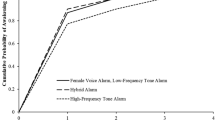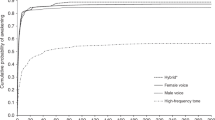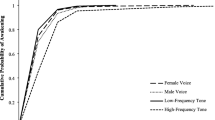Abstract
No previous research has investigated the responsiveness of older adults (65–85 years) to different emergency fire signals during sleep. In this study the auditory arousal thresholds (AAT) of 45 older adults were compared across four signals; the high pitched T-3 (as in current US smoke alarms), a mixed frequency T-3 (500–2500 Hz), a 500 Hz T-3 and a male voice. Participants were carefully screened, including for hearing, and awoken from deep sleep in a repeated measures design. Sounds increased progressively in volume until awakening occurred. It was found that the median AAT for the most effective signal, the mixed frequency T-3, was 20 dBA lower than the median AAT of the least effective signal, the current US high frequency smoke alarm signal. This finding is consistent with previous research, where the high pitched signal required a significantly louder volume than alternatives to wake sleepers of different ages, including children. Those aged over 75 years are especially at risk for sleeping through high pitched signals, probably due to the normal age-related decline in the ability to hear high pitched sounds. The minimum pillow volume of 75 dBA is inadequate for those over 75 years if a 3000 Hz notification signal is used. It is recommended that the high frequency signal currently found in smoke alarms be replaced by an alternative signal that performs significantly better in awakening most of the adult population, once the nature of the best signal has been determined.



Similar content being viewed by others
Notes
The use of the mixed T-3 in these sleep studies started out somewhat serendipitously, with a demonstration CD of a T-3 signal being obtained from Canada, so that the same signal was used in these sleep studies as in the Proulx and Larouche [24] study.
Such a mixed frequency alarm would also be beneficial for those who know they have high frequency hearing loss of any age. While bed vibrators have been shown to be an effective alternative for the hard of hearing [29] their expense makes them unlikely to be widely adopted by older adults who consider their hearing to be average for their age.
References
Berry C.H. (1978) Will Your Smoke Detector Wake You? Fire Journal 72:105–108
Bruck D. (1999) Non-awakening in Children in Response to a Smoke Detector Alarm. Fire Safety Journal 32:369–376
Bruck D., Brennan P. (2001) Recognition of Fire Cues During Sleep. In: J. Shields (ed.), Proceedings of the Second International Symposium on Human Behaviour in Fire (Boston), Interscience Communications, London UK, pp. 241–252
Bruck D. (2001) The Who, What, Where and Why of Waking to Alarms: A Review Fire Safety Journal 36:623–639
D. Bruck, I. Thomas, and A. Kritikos, Investigation of Auditory Arousal with Different Alarm Signals in Sleeping Older Adults, Report for the Fire Protection Research Foundation, 2006. http://www.nfpa.org/assets/files//PDF/Research/Investigation_of_Auditory_Arousal.pdf Accessed 29th June (2007)
Busby K.A., Mercier L., Pivik R.T. (1994) Ontogenic Variations in Auditory Arousal Threshold During Sleep. Psychophysiology 31:182–188
Zepelin H., McDonald C.S., Zammit G.K. (1984) Effects of Age on Auditory Awakening Journal of Gerontology 39(3):294–300
Astrom C., Trjaborg W. (1992) Relationship of Age to Power Spectrum Analysis of EEG During Sleep Journal of Clinical Neurophysiology 9(3):424–430
Carskadon M.A., Dement W.C. (2000) Normal Human Sleep: An Overview In: M.H. Kryger, T. Roth, W.C. Dement (eds.), Principles and Practice of Sleep Medicine, W. B. Saunders Company, Philidelphia, PA, pp. 15–25
Ohayon M.M., Carskadon M.A., Guilleminault C., Vitiello M.V. (2004) Meta-analysis of Quantitative Sleep Parameters from Childhood to Old Age in Healthy Individuals: Developing Normative Sleep Values Across the Human Lifespan Sleep, 27(7):1255–1273
Ball M., Bruck D. (2004) The Salience of Fire Alarm Signals for Sleeping Individuals: A Novel Approach to Signal Design. In: Shields J. (ed.), Proceedings of the Third International Symposium on Human Behaviour in Fire (Belfast), Interscience Communications, London, UK, pp. 303–314
Ball M., Bruck D. (2004) The Effect of Alcohol Upon Response to Fire Alarm Signals in Sleeping Young Adults. In: Shields J. (ed.), Proceedings of the Third International Symposium on Human Behaviour in Fire (Belfast), Interscience Communications, London, UK, pp. 291–302
Bruck D., Bliss R.A. (2000) Sleeping Children and Smoke Alarms. In: Yamada T. (ed.), Proceedings of the Fourth Asia-Oceania Symposium on Fire Science and Technology. Asia-Oceania Association for Fire Science and Technology and Japan Association for Fire Science and Engineering, Tokyo, pp. 603–611
Bruck D., Reid S., Kouzma J., Ball M. (2004) The Effectiveness of Different Alarms in Waking Sleeping Children. In: Shields J. (ed.), Proceedings of the Third International Symposium on Human Behaviour in Fire (Belfast), Interscience Communications, London, UK, pp. 279–290
A. Lee, J. Midgett, and S. White, “A Review of the Sound Effectiveness of Residential Smoke Alarms,” CPSC-ES-0502. US Consumer Product Safety Commission, Washington D.C. 20207-0001. December 2004 (Revised)
Cruickshanks K.J., Wiley T., Tweed T., Klein B., Klein R., Mares-Perlman J.A., Nondahl D.M. (1998) Prevalence of Hearing Loss in Older Adults in Beaver Dam, Wisconsin: The Epidemiology of Hearing Loss. American Journal of Epidemiology 148:879–886
Wallace M.S., Ashman M.N., Matjasko J. (1994) Hearing Acuity of Anesthesiologists and Alarm Detection. Anesthesiology 81:13–28
J.P. Berkowitz, and S.P. Casali, “Influence of Age on the Ability to Hear Telephone Ringers of Different Spectral Content,” in Proceedings of the Human Factors Society 34th Annual Meeting, Santa Monica, Human Factors Society, CA, 1990, pp.132–136
Edworthy J., Loxley S., Dennis I. (1991) Improving Auditory Warning Design: Relationship Between Warning Sound Parameters and Perceived Urgency. Human Factors 33:2312–2326
Edworthy J., Stanton H. (1995) A User-centered Approach to the Design and Evaluation of Auditory Warning Signals: 1. Methodology. Ergonomics 38(11):2262–2280
E.C. Haas, J. Edworthy (1996) Designing Urgency into Auditory Warnings Using Pitch, Speed and Loudness. Computing and Control Engineering Journal 7:193–198
Hall J.R. (Jr) (2005) Characteristics of Home Fire Victims. National Fire Protection Association, Quincy, MA
J.A. Geiman, and D.T. Gottuk, “Reducing Fire Deaths in Older Adults: Optimizing the Smoke Alarm Signal,” 2006. http://www.nfpa.org/assets/files//PDF/Research/Summary_Technical_Report.pdf Accessed 29th June (2007)
Proulx G., Laroche C. (2003) Recollection, Identification and Perceived Urgency of the Temporal-three Evacuation Signal. Journal of Fire Protection Engineering 13:67–82
Frisina D.R., Frisina R.D. (1997) Speech Recognition in Noise and Presbycusis; Relations to Possible Neural Mechanism. Hearing Research 106(1):95–104
Kim S., Frisina R., Frisina R.D. (2002) Effects of Age on Contralateral Suppression of Distortion Product Octoacoustic Emissions in Human Listeners with Normal Hearing. Audiology and Neurology 7:348–357
I. Thomas, and P. Brennan, “Injuries and Fatalities in Apartment Building Fires,” Fire Safety Science––Proceedings of the Seventh International Symposium. D.D. Evans (ed.) Elsevier Science, London, 2002, pp.1085–1096
Wilson W.P., Zung W.K. (1966) Attention, Discrimination, and Arousal During Sleep. Archives of General Psychiatry 15:523–528
Ashley E., Du Bois J., Klassen M., Roby R. (2005) Waking Effectiveness of Audible, Visual and Vibratory Emergency Alarms Across All Hearing Levels. In: Gottuk D.T., Lattimer B.Y. (eds.), Proceedings of the 8th International Symposium of the International Association for Fire Safety Science, Interscience Communications, London, UK, p. 1603
Acknowledgments
This research was supported financially by The Fire Protection Research Foundation of the National Fire Protection Association.
Author information
Authors and Affiliations
Corresponding author
Rights and permissions
About this article
Cite this article
Bruck, D., Thomas, I. Comparison of the Effectiveness of Different Fire Notification Signals in Sleeping Older Adults. Fire Technol 44, 15–38 (2008). https://doi.org/10.1007/s10694-007-0017-5
Received:
Accepted:
Published:
Issue Date:
DOI: https://doi.org/10.1007/s10694-007-0017-5




